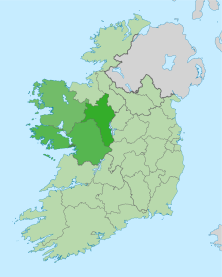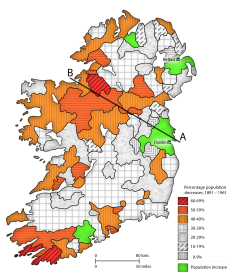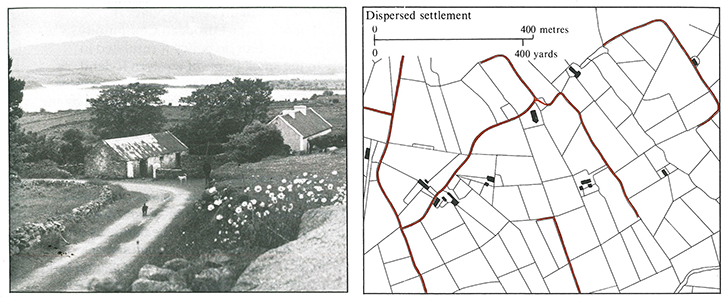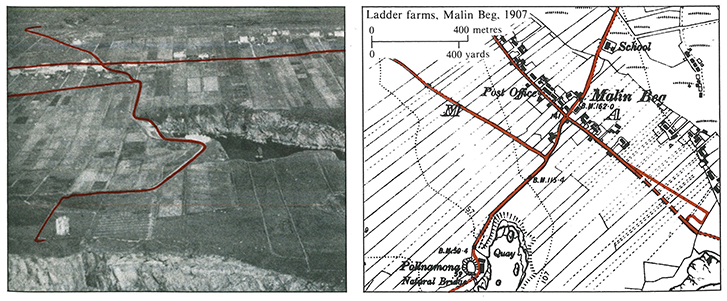👉 Find out about The Open University's Geography courses. 👈
Explore the articles in this collection
-
Change in the West of Ireland
Read now to access more details of Change in the West of IrelandIntroducing a collection of articles asking 'How can unique and distinctive regions, like the West of Ireland, retain the qualities that make them unique while continuing to modernise and interact with the wider world?'

Article
-
Synthesis as a way of understanding the changing uniqueness of rural Ireland
Take part now to access more details of Synthesis as a way of understanding the changing uniqueness of rural IrelandWhat is synthesis? Discover how this way of thinking helps us to understand more about the way in which places retain their uniqueness within wider systems of interdependence.

Activity
-
The West of Ireland: Dimensions of distinctiveness
Read now to access more details of The West of Ireland: Dimensions of distinctivenessHow do you define 'the West of Ireland'? Do you look at cultural factors, geography, or something else?

Article
-
Culture and regional distinctiveness
Read now to access more details of Culture and regional distinctivenessCulture and how language identifies that culture are key to understanding what makes a region unique.

Article
-
The rural dimension – rundale in the West of Ireland
Read now to access more details of The rural dimension – rundale in the West of IrelandThe rundale system once governed how farmland was distributed between tenants in Ireland. It supposedly died out in the 19th century, but this was not actually the case in some parts of the West of Ireland.

Article
-
A changing uniqueness – The changing ‘place’ of the West
Read now to access more details of A changing uniqueness – The changing ‘place’ of the WestThe population of Western Ireland declined dramatically between 1891 and 1961. How do you think this affected Ireland as a whole?

Article
-
The realities of rural life in the 1950s-1980s
Watch now to access more details of The realities of rural life in the 1950s-1980sThe period of the 1950s to 1980s was the beginning of modernisation in community life and farming and the development of manufacturing industry in the West of Ireland.

Video
-
Culture and the manufacturing industry, 1983
Watch now to access more details of Culture and the manufacturing industry, 1983In 1983, the fight to retain a unique Irish speaking culture meant that jobs had to be created locally in manufacturing and tourism so that Irish speakers no longer had to emigrate, but industrialisation also threatened the survival of the Irish language.

Video
-
The dilemma of tourism and the Irish language, 1983
Watch now to access more details of The dilemma of tourism and the Irish language, 1983Father James McDyer discusses the dilemma of the Glencolmcille holiday village between development, language and culture and the threat of depopulation. Tourism is important for economic development but what impact does it have on local culture and the Irish language?

Video
-
A new layer: Culture, the Irish language and identity in 2015
Watch now to access more details of A new layer: Culture, the Irish language and identity in 2015We revisit the Glencolmcille folk village in 2015 to see whether the dilemma of development and the local language and culture has been resolved.

Video
-
Southwest Donegal: uniqueness and interdependence in 2015
Read now to access more details of Southwest Donegal: uniqueness and interdependence in 2015In Southwest Donegal, we see both the local uniqueness and different interdependencies and interconnections with other places.

Article
-
The future of rural Ireland - nuances, scale and fighting back
Read now to access more details of The future of rural Ireland - nuances, scale and fighting backThe future of rural Ireland - nuances, scale and fighting back

Article
Once wider social processes impacted on the rundale system, the delicate balance which it had maintained was broken and the result was poverty and political reaction. The eventual outcome was complete reform of the system of landholding and settlement that created compact, independent, small farms. The pattern preferred by the Irish Government’s Commissioners was ‘squared’ farms with a dwelling centred on the holding. This might have been useful for efficiency of agricultural organisation, but isolated the dwelling from its neighbours and hence was at variance with traditional social practice.
 A rundale cluster in Malin Beg
A rundale cluster in Malin Beg
This pattern now prevails over much of rural Ireland, but in many parts of the West one sees a variant in the so-called ‘ladder’ farms where dwellings are strung out like a street and holdings run parallel to one another and perpendicular to the line of settlement.
 Dispersed farmsteads
Dispersed farmsteads
These ‘ladder farms’ represent a compromise between the old and the new; it is one way in which the operation of ‘national’ processes has been affected by the local culture and environment. The maps of Malin Beg in Southwest Donegal show that a rundale cluster in 1840 has been replaced by ladder farms by 1907.
 Ladder farms
Ladder farms
Comparison between the patterns of a rundale cluster and ladder farms illustrate the visible change in the landscape and also the way in which social change is mediated between the local social systems and the wider social context. It is not that the patterns of landholding did not exist elsewhere that makes the West of Ireland unique; it is the manner in which this set of characteristics has survived and influenced the present pattern of social relationships. (Image source)
Transcript: Ladder farms at Malin Beg, Southwest Donegal, 1983
PAT JESS: This landscape behind me at Malin Beg is called ladder farms. It’s a good description but it doesn’t explain very much. In order to understand how it came to be as it is, we need to know something of society processes, the cultural context and the role of the physical environment and how those combine and change over time. In order to reconstruct past landscapes, we rely heavily on secondary sources. For example, the first edition of the Ordnance Survey for this area, taken in the middle of the last century, shows no field boundaries here at all and the settlement clustered up in the middle of what is now a long row of houses. The change was obviously dramatic, effected through the political process and forced by Act of Parliament. It was socially traumatic as well, but, remarkably, changed agricultural practice extremely little.
As well as the new landscape, land redistribution created a new class of ‘peasant proprietors’, the owner occupiers of the small farms. Staunchly conservative in culture, attitudes, politics and agricultural practice, this class came to dominate rural society. The deep attachment to land, a characteristic of traditional rural societies, featured strongly amongst these farmers for whom the land had been hard won. They remained unwilling to part with it in more recent times and resisted government programmes such as farm amalgamation schemes. These farmers have also been slow to innovate or change their use (or non-use) of their land and commercial agriculture has stagnated as a result.
Context and interdependencies
But the wider context has been inhibiting for them too. Until the 1960s Irish agriculture was locked into a British market where a policy of cheap food for an urban industrial society dominated, and so rural Ireland remained economically dependent on Britain despite political independence. Now that Ireland is a member of the European Union, agriculture and much of rural society is dependent on policy formulated in Brussels which is often inappropriate to the small farms in the West of Ireland, In other words, in successive systems of interdependence, farmers in the West of Ireland have been constrained by the wider context of which they were part.
Land redistribution was supposed to produce a general improvement in rural conditions. However, while landownership conferred social status, the small family farm did not provide a good income. Many of the farms depended as much on money sent home by migrant members of the family, working in cities in North America such as Boston and New York, than on income from agriculture. This represents another set of interdependencies within a wider geographical context. The apparently isolated farm in the West of Ireland remained far from independent. Generally, the families were large, but only one son could inherit the farm. There were few opportunities for alternative employment. Emigration, which had reached high levels before the changes in landholding, continued.
With many of the young and enterprising choosing to emigrate, communities in the West of Ireland became isolated and depressed by the continuing losses of traditional rural society to urbanism and industrial capitalism. From the world outside, the West of Ireland looked either hopelessly backward or beautifully unspoiled, depending on the point of view.
Explore the articles in this collection
-
Change in the West of Ireland
Read now to access more details of Change in the West of IrelandIntroducing a collection of articles asking 'How can unique and distinctive regions, like the West of Ireland, retain the qualities that make them unique while continuing to modernise and interact with the wider world?'

Article
-
Synthesis as a way of understanding the changing uniqueness of rural Ireland
Take part now to access more details of Synthesis as a way of understanding the changing uniqueness of rural IrelandWhat is synthesis? Discover how this way of thinking helps us to understand more about the way in which places retain their uniqueness within wider systems of interdependence.

Activity
-
The West of Ireland: Dimensions of distinctiveness
Read now to access more details of The West of Ireland: Dimensions of distinctivenessHow do you define 'the West of Ireland'? Do you look at cultural factors, geography, or something else?

Article
-
Culture and regional distinctiveness
Read now to access more details of Culture and regional distinctivenessCulture and how language identifies that culture are key to understanding what makes a region unique.

Article
-
The rural dimension – rundale in the West of Ireland
Read now to access more details of The rural dimension – rundale in the West of IrelandThe rundale system once governed how farmland was distributed between tenants in Ireland. It supposedly died out in the 19th century, but this was not actually the case in some parts of the West of Ireland.

Article
-
A changing uniqueness – The changing ‘place’ of the West
Read now to access more details of A changing uniqueness – The changing ‘place’ of the WestThe population of Western Ireland declined dramatically between 1891 and 1961. How do you think this affected Ireland as a whole?

Article
-
The realities of rural life in the 1950s-1980s
Watch now to access more details of The realities of rural life in the 1950s-1980sThe period of the 1950s to 1980s was the beginning of modernisation in community life and farming and the development of manufacturing industry in the West of Ireland.

Video
-
Culture and the manufacturing industry, 1983
Watch now to access more details of Culture and the manufacturing industry, 1983In 1983, the fight to retain a unique Irish speaking culture meant that jobs had to be created locally in manufacturing and tourism so that Irish speakers no longer had to emigrate, but industrialisation also threatened the survival of the Irish language.

Video
-
The dilemma of tourism and the Irish language, 1983
Watch now to access more details of The dilemma of tourism and the Irish language, 1983Father James McDyer discusses the dilemma of the Glencolmcille holiday village between development, language and culture and the threat of depopulation. Tourism is important for economic development but what impact does it have on local culture and the Irish language?

Video
-
A new layer: Culture, the Irish language and identity in 2015
Watch now to access more details of A new layer: Culture, the Irish language and identity in 2015We revisit the Glencolmcille folk village in 2015 to see whether the dilemma of development and the local language and culture has been resolved.

Video
-
Southwest Donegal: uniqueness and interdependence in 2015
Read now to access more details of Southwest Donegal: uniqueness and interdependence in 2015In Southwest Donegal, we see both the local uniqueness and different interdependencies and interconnections with other places.

Article
-
The future of rural Ireland - nuances, scale and fighting back
Read now to access more details of The future of rural Ireland - nuances, scale and fighting backThe future of rural Ireland - nuances, scale and fighting back

Article
Rate and Review
Rate this video
Review this video
Log into OpenLearn to leave reviews and join in the conversation.
Video reviews